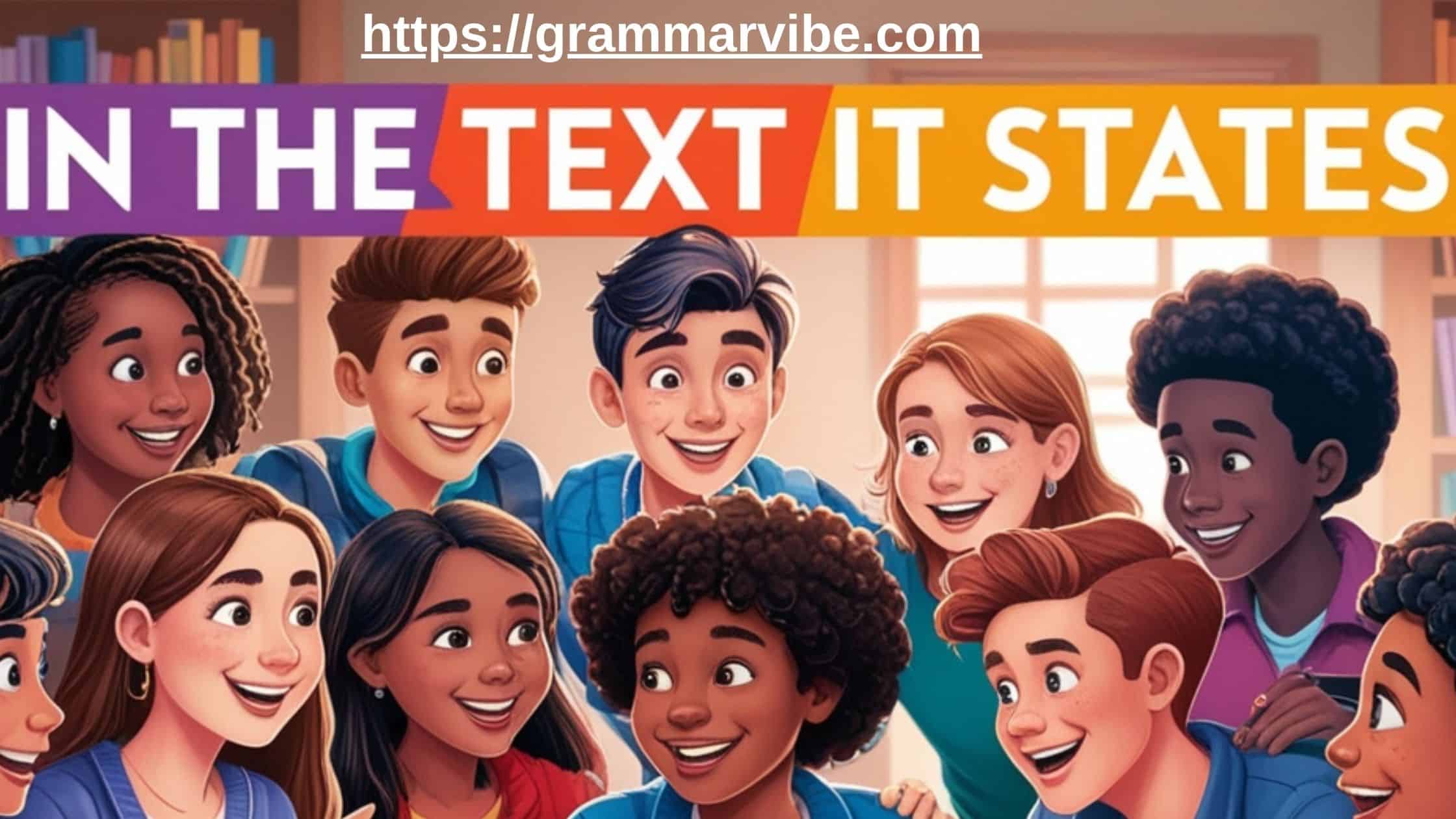In academic writing, effectively citing source material is crucial to presenting well-supported arguments and analyses. However, overusing phrases like “in the text it states” can make your writing feel repetitive and monotonous. To improve your writing flow and showcase writing sophistication, it’s essential to vary how you introduce quotations and paraphrases.
Below are 15 other ways to say “in the text it states”, complete with practical examples to enhance your academic writing skills.
1. The Author Asserts That…
This phrase works well when you want to emphasize the author’s strong claims or the validity of their position. It suggests confidence in the argument.
Scenario Example: Email to a Classmate
Subject: Clarification on Climate Change Article
Hey John,
In our recent article on climate change, the author asserts that climate change poses an existential threat to humanity. This view is supported by the fact that the Earth’s average temperature has been rising steadily over the last century. We could use this as the foundation for our next paper on environmental issues.
Best,
Sarah
2. According to the Passage…
Using this phrase highlights a specific detail or claim made within the text itself. It’s ideal when you need to refer to a specific section of the source.
Scenario Example: Email to a Professor
Subject: Inquiry About Reading Material
Dear Professor Miller,
According to the passage, the author describes the intricate relationship between technology and society and how it shapes our daily lives. Could you clarify this concept further during the next lecture? It would help strengthen my analysis for the upcoming research paper.
Best regards,
Peter
3. The Text Indicates That…
This phrase suggests a more subtle observation or implication within the text, rather than a direct or bold statement.
Scenario Example: Research Paper
In their study, the text indicates that younger generations are more likely to engage with social media than older demographics. This finding supports the hypothesis that social platforms are shaping communication habits across age groups.
More for you: 15 Other Ways to Say “Please Advise”
4. As Explained in the Reading…
This phrase is perfect for clarifying points that were discussed in the reading, making it a strong way to introduce textual explanations.
Scenario Example: Email to a Classmate
Subject: Notes on Reading for History Class
Hi Emily,
As explained in the reading, the French Revolution had many underlying causes, including economic disparity and the influence of Enlightenment thinkers. I think this could be a great point to develop in our essay.
Best,
Rachel
5. The Article Points Out That…

This phrase highlights a notable observation in the article, helping you point out key facts that may be important for your argument.
Scenario Example: Academic Paper
In the article, the author points out that the rise of artificial intelligence has drastically transformed industries such as manufacturing and healthcare. This could be useful source material when discussing the impact of technology in the next section of the paper.
6. The Writer Notes That…
When you want to emphasize a specific comment or remark made by the author, this is a great alternative. It brings attention to something noteworthy within the text.
Scenario Example: Research Paper
The writer notes that many ancient civilizations valued education highly, seeing it as a tool for personal and societal growth. This observation could be an interesting paraphrase for the introduction to our section on education history.
7. The Source Mentions That…
This phrase refers to the source material itself, helping you present the text as a point of reference in your academic writing.
Scenario Example: Email to a Fellow Student
Subject: Clarification on Book Chapter
Hey Alex,
The source mentions that the economic downturn following the 2008 financial crisis led to a significant increase in unemployment rates. This could be a pivotal point for our next essay on global economics.
Cheers,
Jessie
For your interest: 15 Other Ways to Say “Great Asset to the Team”
8. The Material Suggests That…
This phrase is helpful when discussing ideas or findings that suggest a possibility rather than providing conclusive evidence.
Scenario Example: Research Paper
The research material suggests that a lack of sleep may impair cognitive functions, including memory retention and problem-solving abilities. This supports our thesis on the importance of sleep in academic performance.
9. The Evidence Shows That…
Ideal for situations where the source provides clear data or facts that back up a claim, this phrase emphasizes textual evidence and strong text analysis.
Scenario Example: Academic Paper
In their study, the evidence shows that students who engage in active learning techniques outperform their peers in exams. This finding reinforces our argument for more interactive teaching methods in schools.
10. The Quotation Reveals That…
Use this phrase when directly referring to a quotation from the text that reveals something significant or insightful.
Scenario Example: Email to a Professor
Subject: Question on Essay Structure
Dear Professor Thompson,
The quotation reveals that even the most established institutions are vulnerable to systemic failure. Could you recommend any additional sources to back up this argument in my academic paper?
Sincerely,
David
You might also like: 15 Other Ways to Say “You As Well”
11. The Research Demonstrates That…
When referencing scholarly research that presents findings, this phrase shows the validity of the claims being made.
Scenario Example: Research Paper
The research demonstrates that early exposure to foreign languages enhances cognitive flexibility and improves problem-solving skills. This could be a key point for the section on language acquisition.
12. The Author Highlights That…

This is another way to introduce a significant idea the author emphasizes in the text, especially if it’s central to the overall message.
Scenario Example: Email to a Classmate
Subject: Key Points for Paper
Hey Mark,
The author highlights that the role of women in history has often been overlooked, and this is something we should definitely explore in our essay. Let me know what you think!
Best,
Nina
13. As Stated in the Text…
A simple but effective alternative that maintains clarity and formality. Use it when you want to restate something that’s directly mentioned in the text.
Scenario Example: Research Paper
As stated in the text, environmental sustainability is no longer just a matter of local concern, but a global issue. This supports the importance of our topic in the broader context of international relations.
14. According to the Author…
This phrase is perfect when you want to directly reference what the author claims in the text.
Scenario Example: Academic Paper
According to the author, the economic crisis of the 1970s was a turning point for global trade policies. This historical perspective will add depth to our analysis of modern economic trends.
Check out this: 15 Other Ways to Say “How Much”
15. The Source Provides Evidence That…
This expression is ideal when you are summarizing textual references that provide substantial proof for a claim.
Scenario Example: Email to a Classmate
Subject: Discussion on Paper Topic
Hey Tom,
The source provides evidence that climate change is not just a scientific issue but also a socio-economic one. We could use this point as the foundation for our paper’s introduction.
Cheers,
Emma
Table of Synonyms
| Alternative Phrase | Example |
|---|---|
| The author asserts that… | The author asserts that digital learning is the future of education. |
| According to the passage… | According to the passage, this policy will reduce unemployment rates. |
| The text indicates that… | The text indicates that students who sleep better tend to perform better. |
| As explained in the reading… | As explained in the reading, photosynthesis is vital for plant growth. |
| The article points out that… | The article points out that AI is rapidly transforming industries. |
| The writer notes that… | The writer notes that effective leaders often prioritize communication. |
| The source mentions that… | The source mentions that the company has expanded to international markets. |
| The material suggests that… | The material suggests that reading enhances cognitive development. |
| The evidence shows that… | The evidence shows that increased exercise improves mental health. |
| The quotation reveals that… | The quotation reveals that education is the key to societal progress. |
| The research demonstrates that… | The research demonstrates that early intervention leads to better outcomes. |
| The author highlights that… | The author highlights that social media has reshaped modern communication. |
| As stated in the text… | As stated in the text, the Great Barrier Reef is in peril due to climate change. |
| According to the author… | According to the author, war is often a consequence of economic instability. |
| The source provides evidence that… | The source provides evidence that mindfulness can reduce stress. |
Conclusion
By incorporating these alternative phrases into your writing, you can eliminate repetitive patterns like “in the text it states” and improve your writing style. These alternatives not only enhance your reading comprehension but also help you maintain reader engagement by creating a smoother flow and varied sentence structures.
Whether you are working on research papers, essays, or any academic writing, citing sources in diverse and creative ways is essential for academic writing improvement. Always strive for clarity and ensure that your source introduction matches the tone and complexity of your argument.

Kyren Paul is an experienced blogger and the creative mind behind “Grammar Vibe.” With a passion for the nuances of English grammar, he brings clarity and insight to everyday language topics, making grammar accessible and engaging for readers of all levels.











Leave a Comment